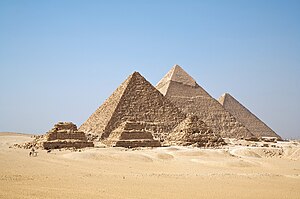The Seven Wonders of the World/The Great Pyramid

The Great Pyramid at Giza is the only one of the seven wonders that is still standing today. Built by the Egyptians between 2575-c. 2465 BCE, the Great Pyramid is one of many large pyramid structures built to honor dead Pharaoh. The Giza Plateau, or "Giza Necropolis" in the Egyptian Valley of the Dead contains several pyramids (of which the great pyramid is the largest), several small tombs, several temples, and the great Sphinx.
The great pyramid was created to honor the Pharaoh Khufu, and many of the smaller pyramids, tombs, and temples were built to honor Khufu's wives and family members.
Biography: Khufu[edit | edit source]

Khufu was the son of King Sneferu, and Queen Hetepheres. Khufu is remembered as a cruel and ruthless Pharaoh in later folklore. Khufu had nine sons, one of whom, Djedefra, was his immediate successor.
It is generally thought that Khufu came to the throne in his twenties. Accounts differ on how long he was Pharaoh, with accounts claiming he ruled for anywhere between about 23 years to 65 years. He started building his pyramid at Giza, the first to be built in that place. Based on inscriptional evidence, it is also likely that he led military expeditions into the Sinai, Nubia and Libya.
The Westcar Papyrus, which was written well after his reign during the Middle Kingdom or later, depicts the Pharaoh being told magical tales by his sons Khafra and Djedefra. This story cycle depicts Khufu as mean and cruel, and is ultimately frustrated in his attempts to ensure that his dynasty survives past his two sons. Whether or not this story cycle is true is unknown, But Khufu's negative reputation lasted at least until the time of Herodotus, who was told further stories of that king's cruelty to his people and to his own family in order to ensure the construction of his pyramid. What is known for certain is that his funerary cult lasted until the 26th Dynasty, which was one of the last native-Egyptian royal dynasties, almost 2,000 years after his death.
Most likenesses of Khufu are lost to history. Only one miniature statuette (right) has been fully attributed to this Pharaoh. Since he is credited with building the single largest building of ancient times, it is ironic that the only positively identified royal sculpture of his is also the smallest that has ever been found: a 7.6cm (3 inch) ivory statue that bears his name. It was discovered not at Giza, but in a temple in Abydos during an excavation by William Matthew Flinders Petrie in 1903. Originally this piece was found without the head, but bearing the Pharaoh's name. Realizing the importance of this discovery, Petrie halted all further excavation on the site until the head was found three weeks later. This statue is now on display in the Egyptian Museum, Cairo.
Location: Giza[edit | edit source]
The Giza plateau is an area outside of modern day Cairo. Because of the several pyramids, tombs, and graveyards on the plateau, the area is commonly known as the "Giza Necroplex". The plateau itself is part of the town of Giza.

Giza is 20 miles away from the Nile river, and has become part of the Cairo metropolis. Many images of the Giza plateau show a vast desert, but modern day Giza is a thriving town with a substantial population. During British colonization in the 19th and early 20th centuries, many roads and buildings were constructed in the area to help support the local commerce.
